Almost everyone has heard that 20% of businesses fail in their first year of operations, and 60% go under within the first three years. But have you ever stopped to consider why? Market research shows that 35% to 45% of startups fail due to product-market misalignment. But, this problem is not exclusive to just startups. Fortune 100 companies including Google, Coca-Cola, Pepsi, and Walt Disney, have experienced product failures due to badly misunderstanding their customers.
Through our entrepreneur assistance program here at Vertical Motion, we have seen and experienced the struggles of trying to launch a successful business. From human resource management to product design and development, the attention of entrepreneurs is regularly moving from one thing to another, leaving little time for education and growth. To help you learn, understand, and apply vital concepts that will elevate your business, we’ve created “An Entrepreneurs Guide To” articles. They offer step-by-step instructions on how to complete core business documents in little time.
In this article, you will learn the purpose of the value propositions canvas, why it is vitally important for businesses, in what situations it should be used, followed by step-by-step instructions on how best to complete a value proposition canvas. As a bonus, we have included a Vertical Motion designed value proposition canvas for you to apply the concepts learned in this article!
3… 2… 1… Liftoff!
What Is a Value Proposition Canvas?
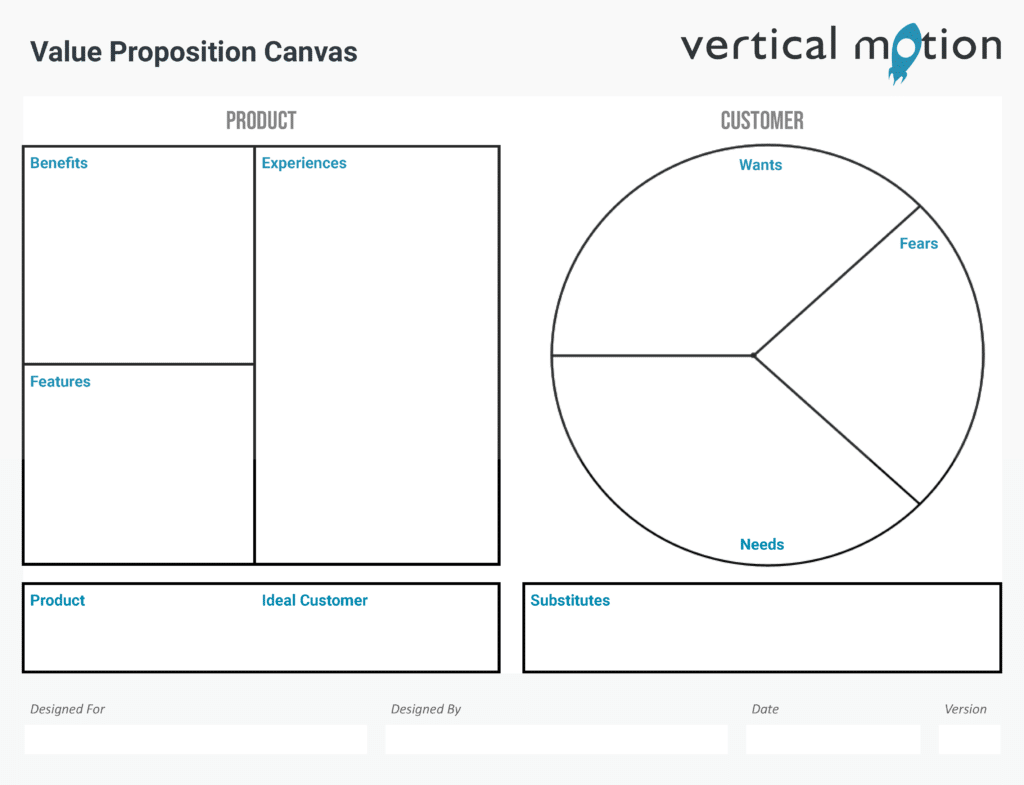
The value proposition canvas is a tool to help entrepreneurs ensure their product or service aligns with the needs of their target market. This business principle, known as product-market fit, is critically important for the success of all businesses.
The value proposition canvas combines two elements of the business model canvas, specifically, Customer Segments and Value Proposition. Customer Segments or Customer defines the wants, needs, and fears of your target audience through a detailed analysis of what motivates and shapes their decisions. Value Proposition or Product outlines the core benefits, features, and experiences your solution offers. Shaped by your customer persona, the benefits, features, and experiences strive to meet your customers’ needs, fulfill their wants, and overcome their fears.
Think of the value proposition canvas as an equilibrium. If your customer and your product are not aligned, it is unlikely that you will convince them to switch from their existing solution to yours. Let’s use Mercedes-Benz as an example. Mercedes manufactures and sells luxury vehicles to individuals interested in high-performance automobiles that align with their sense of identity. Subsequently, their cars have advanced features like genuine leather interiors, touch controls, and high-speed engines. Instead, if Mercedes targeted low-income families, their luxury product offering would not achieve product-market fit and ultimately not sell. That is why aligning your product with the needs of your audience is vital to long-term success.
Why Is a Value Proposition Canvas Important?
Building a business or new product isn’t easy. Entrepreneurs invest a lot of time, money, and sweat equity to achieve success. As a result, too many valuable assets are at risk to launch a product you haven’t tested. Think of it this way. Would it be wise to buy a home without inspecting it first? No, of course not! You want to ensure you and your family are safe before spending that sum of money. Similarly, business owners and new founders alike need to “inspect” the fit between the needs of their customers and the value offered by their product before investing valuable resources.
That’s where the value proposition canvas comes in. It offers enhanced visibility into your product and your customer to ensure proper product-market fit before resource investment.
When Should a Value Proposition Canvas Be Used?
There are two main situations when you should use a value proposition canvas.
First, whenever a new product or service is in development. We’ll use Apple as an example. When Apple launched their first computer (Apple I) in 1976, the company positioned itself as a computer manufacturer. Since then they’ve expanded their product offering to include portable MP3s (iPod – 2001), smartphones (iPhone – 2007), streaming media players (Apple TV – 2007), tablets (iPad – 2010), smartwatches (Apple Watch – 2015), smart speakers (HomePod – 2017), and even electric cars (Apple Electric Car – Estimated Launch. 2027). With each new idea Apple proposed, they needed to ensure there was a sizeable market that would benefit from purchasing their product. That’s why Apple has achieved the success they have. Not because they make flashy products, but because their products serve a need, fulfill a want, and overcome their customers’ fears.
Second, when an existing product or service requires refinement. Consider Booster Juice for a moment. In 2016, Booster Juice changed the recipe of a number of its smoothies by replacing soy milk with almond milk. Signature smoothies including Funky Monkey, Matcha Monsoon, and Mind Over Matcha switched to almond milk. Although this is a minor adjustment, in theory, it had a significant impact on the customers of Booster Juice. Think about individuals with allergies, dietary restrictions, or different taste preferences. However, a change such as this doesn’t happen without a thorough analysis of the needs, wants, and fears of your customers beforehand. Now six years later, it’s clear that their refined product offering was, at least in part, aligned with their target market as they remain a popular Canadian smoothie franchise.
How Do I Complete a Value Proposition Canvas?
To better understand the process of completing a value proposition canvas, we’ll use Apple’s Launch of the iPhone as an example. We have also developed a fictional ideal customer named Holly, who we will use throughout this tutorial.
To follow along, download the Vertical Motion designed value proposition canvases below.
First Steps

Firstly, start by inputting the name of your business (Apple Inc.), your name or the name of the person completing the value proposition canvas (Steve Jobs), the date of creation (08/09/2005), version number (1.00), name of the product (iPhone) and ideal customer (Holly).
Customer
Needs
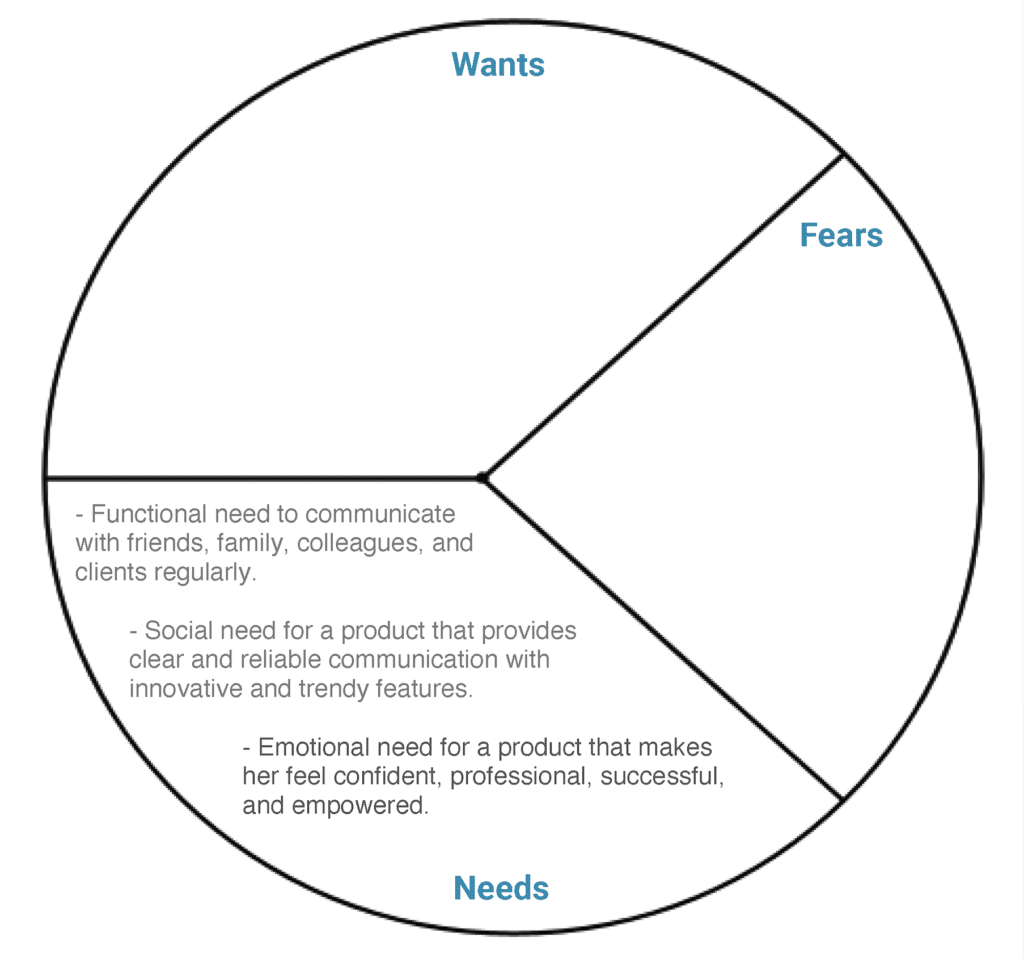
Needs are associated with the prefrontal cortex which is the rational part of the human brain. Generally, needs are reoccurring objectives that customers must complete. Think of needs like jobs. For a company to function as intended, it needs to hire employees to perform jobs that help the company succeed. Similarly, your customer “hires” products and services to fulfill functional, social, and emotional “jobs” or needs.
Functional needs are the most basic of the three and refer to essential tasks in one’s day-to-day life. A functional need for Holly is to communicate with friends, family, colleagues, and clients regularly. Therefore, she needs to hire a product or service that helps her to meet this need.
Social needs refer to how an individual wants to be perceived by others while using a product. Although not a primary concern, social needs also influence the buying decision. In Holly’s case, she works as a sales representative, which requires her to make good first impressions with clients through conversations commonly held over the phone. She also has a close friends group that likes to stay up to date with the latest tech trends. To fulfill her social needs, Holly is searching for a product that provides clear and reliable communication with innovative and trendy features.
Emotional needs refer to how a customer wants to feel when using a product. Similar to social needs, emotional needs are secondary to functional. As an enthusiastic and creative young woman, Holly needs a product that makes her feel confident, professional, successful, and empowered.
Wants
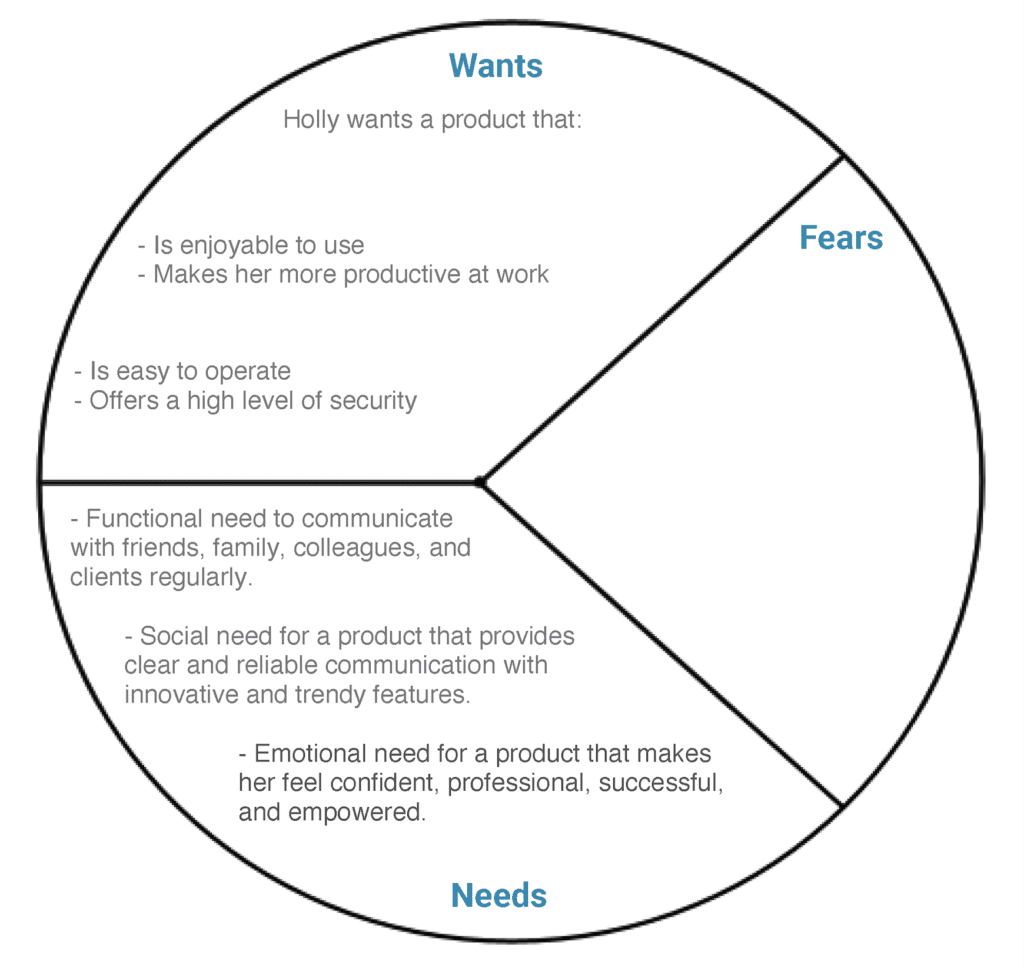
Wants are associated with the limbic system of the brain which is responsible for behavioural and emotional responses. These wants represent desired preferences for how your customer resolves a need. To recap, we have identified three needs Holly has. The first is a functional need for communication. The second is a social need to feel accepted by clients and peers. Finally, the third is an emotional need to maintain high self-esteem. Beyond these needs, Holly wants or prefers a product that is enjoyable to use, makes her more productive at work, is easy to operate, and offers a high level of security.
Fears
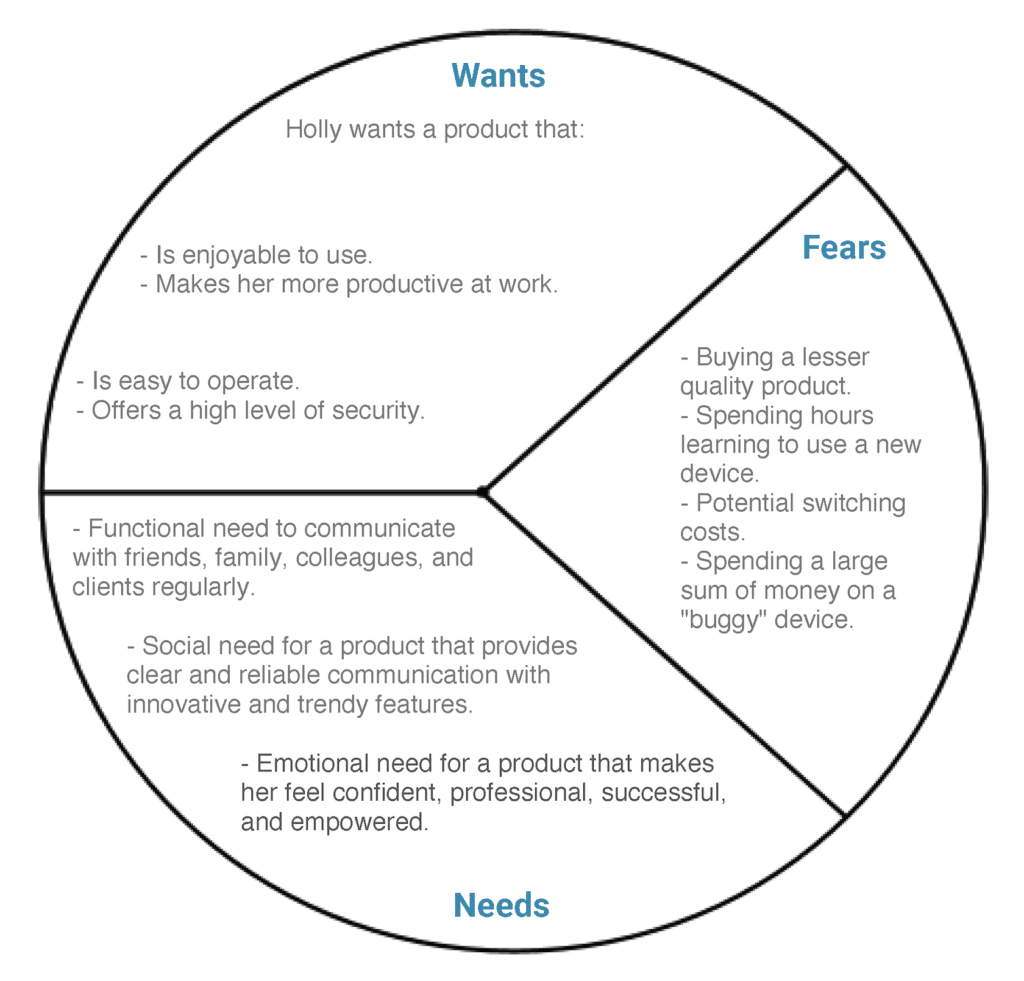
Fears are powerful emotions that strongly influence buyers in making a purchasing decision. It often centers around fears of making mistakes or missing out on better alternatives. These fears tend to be the unknown reasons for low sales and the hidden drivers behind a customer’s wants and needs. Therefore, even if your product is superior to your competitor, it may not be significant enough to overcome consumer complacency. For Holly, her biggest fears are buying a lesser quality product, spending hours learning to use a new device, potential switching costs or inconveniences of transferring products, and spending a large sum of money on a new and perhaps “buggy” device.
Product
After completing the Customer section, you are ready to begin the Product components. Designers are free to start with either Benefits or Features. It is encouraged that Experiences be completed last, as they represent the combined sum of features and benefits. We suggest starting with Benefits as they relate directly to the needs and wants of your customer. Features on the other hand focus on functionality which may encourage you to stray away from the main purpose of your product which is to serve your customer.
Benefits
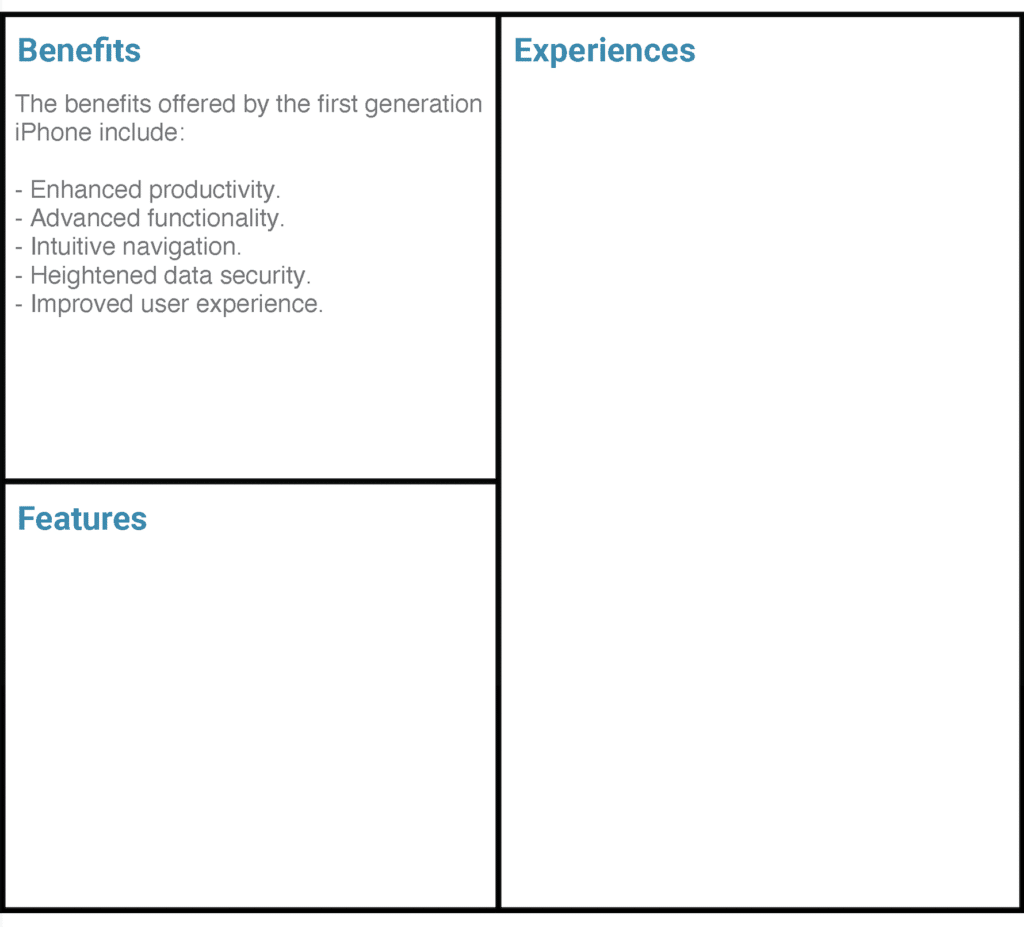
Features
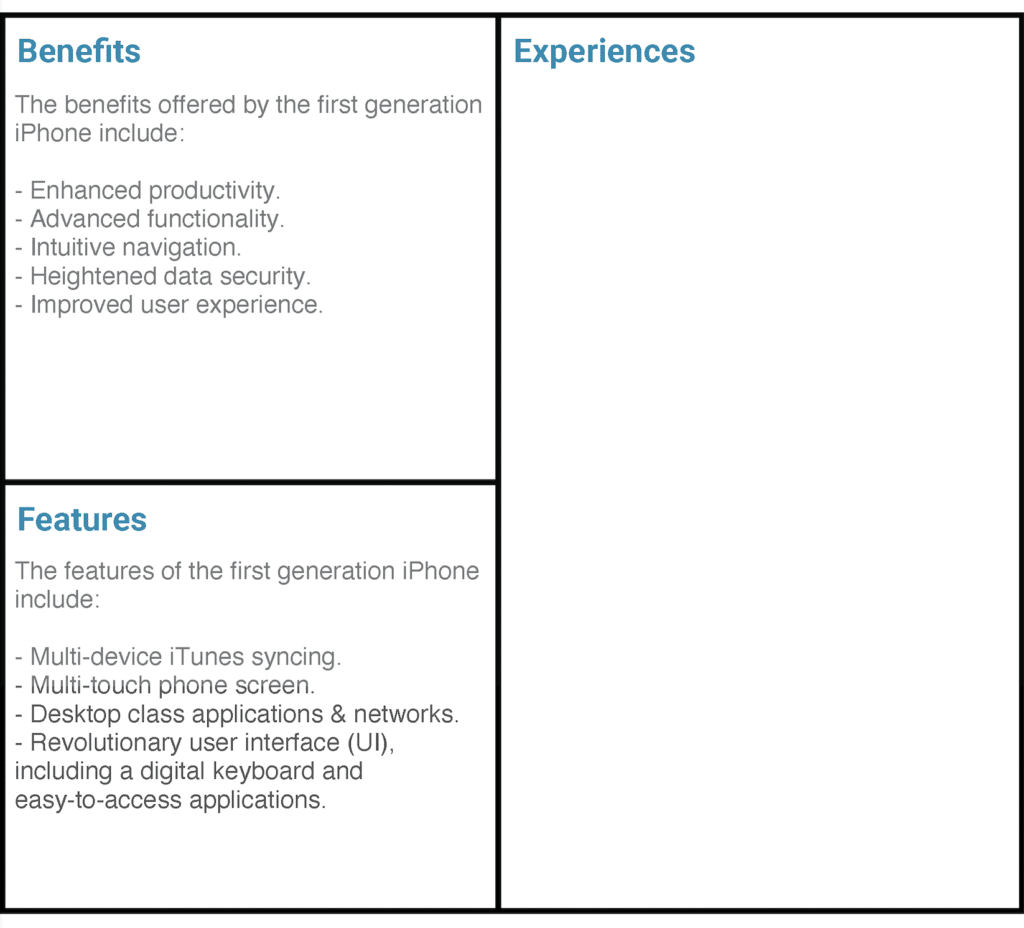
Experiences
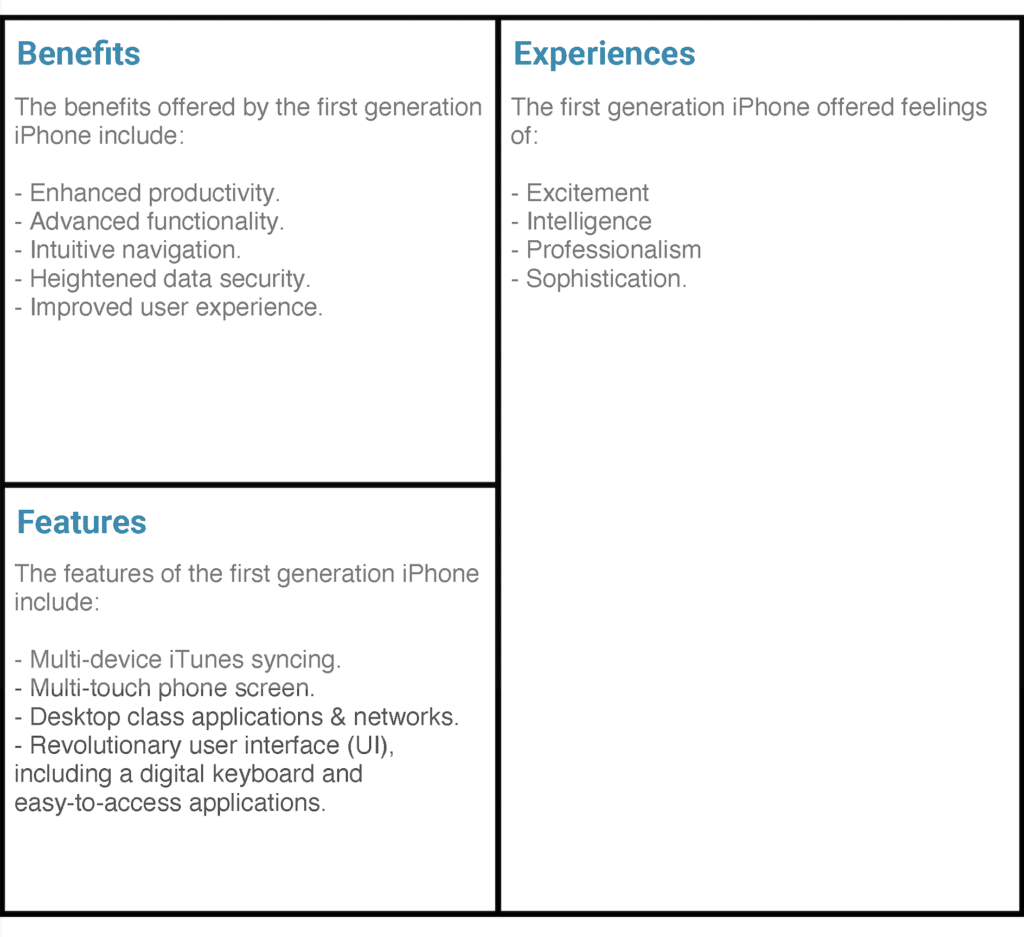
Substitutes

The final section of the value proposition canvas is Substitutes.
Substitutes are the products or services that are directly or indirectly in competition to serve the same customer need. For example, Coca-Cola is in direct competition with Pepsi as they both manufacture carbonated pop beverages to quench thirst. In contrast, Nestlé Pure Life water indirectly competes with both Coke and Pepsi as it equally quenches thirst but in a different way. Do not make the mistake of only listing competitor products. Substitutes can also include behaviours, actions, processes, and procedures that your customer uses as an alternative method to solving their problem.
For Holly, her substitutes for the iPhone include BlackBerry, HTC, Nokia, payphones, home and office landlines.
Final Thoughts
Starting a business is challenging. The large number of resources invested in launching a product or service places entrepreneurs under immense pressure to succeed. Therefore, it is vital to establish a strong product-market fit for the long-term success of your business. The value proposition canvas is an excellent tool to assist you in doing this as it requires you to thoroughly understand your customers, including their needs, wants, and fears. Furthermore, it helps business owners and entrepreneurs wisely use scarce resources and reduce product iterations. In doing so, your business will be better able to serve your customers and achieve success in today’s competitive market.
That being said, the value proposition canvas is just the starting point in understanding your customers. Until this information is validated with your target audience, it simply remains a hypothesis. For that reason, it’s important to speak with your prospective customers as soon as possible to validate your beliefs. The more individuals you can speak with the better as it will help you formulate a clearer idea of their needs, wants, and fears.
Should you have any questions or need support in launching your business, Vertical Motion is here to help. Our coaches and business advisors would be happy to guide you from idea to execution and beyond.

Want to Stay Connected?
Vertical Motion Inc. is a Calgary & Kelowna-based business supporting the needs of entrepreneurs and business owners since 2006. Our team of expert business specialists, project managers, front and back-end developers, marketers, graphic designers, and professional advisors support the needs of both B2B and B2C businesses in all industries including Blockchain, Cryptocurrency, Clean Technology, Augmented and Virtual Reality (AR/VR), Sports and Recreation, Real Estate, and Health Care. We specialize in creating custom Web, iPhone, Android, and Windows solutions for businesses of all sizes including startups, small businesses, not-for-profit organizations, and large corporations. Ready to take your idea to new heights? Drop us a line
Not quite ready yet? Sign up for our monthly newsletter for relevant business articles, Vertical Motion blogs, and our business Q & A. Have no fear we are spam clear! 🚀
Written By Tyler Mikitka, communications officer on the bridge at Vertical Motion.
